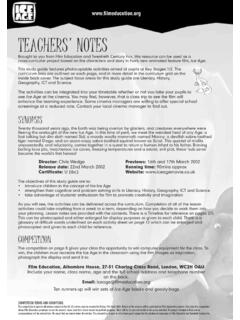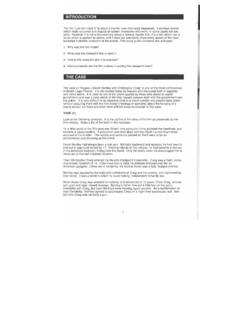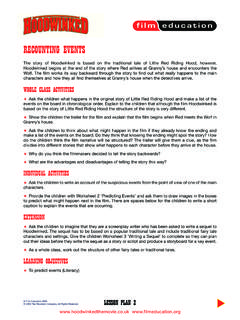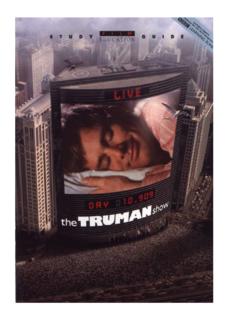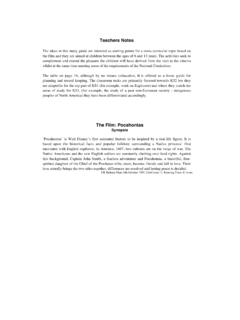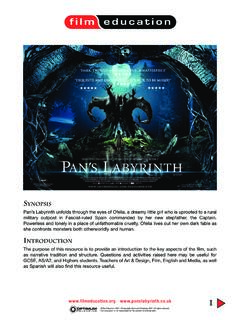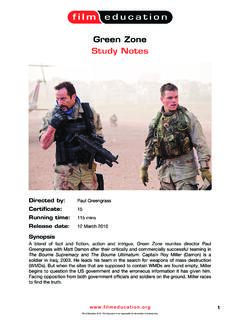Transcription of ABOUT THE FILM
1 ABOUT THE FILM. The Lives of Others, directed by Florian Henckel von Donnersmark, focuses on the cultural scene in East Berlin during the German Democratic Republic (GDR) in the middle of the 1980s. It illuminates the corrupt system during the communist regime of the GDR. It was a regime which was characterised by espionage and inhumane and morally doubtful acts. In the film, the Stasi commissar Gerd Wiesler, a faithful supporter of the totalitarian regime, has been instructed to observe the popular artistic couple Christa-Maria Sieland and Georg Dreyman who work at a theatre and devote their life to cultural and intellectual exchange. By eavesdropping on the couple, Wiesler penetrates into the lives of the others'. Suddenly the loyal communist is faced with a forbidden and for him inaccessible world a world full of free spirit, passion, challenge and diversity.
2 Much of the film was shot on location in East Berlin in the original settings, for example, at the former Stasi prison Hohensch nhausen' (which is now a memorial place for the victims of the communist tyranny in Germany) and at the former Ministry of State Security. The location shots of Dreyman's apartment were filmed on Wedekindstrasse in Berlin-Friedrichshain. Film Education 2007 and Copyright 2007 Lionsgate Films. All Rights Reserved 1. HISTORICAL CONTEXT. The Potsdam Conference The Potsdam Conference was held at Cecilienhof in Potsdam, Germany, from July 17 to August 2, 1945. The participants at this conference were the Soviet Union (represented by Communist Party General Secretary Joseph Stalin), the United Kingdom (represented by Prime Minister Winston Churchill and later Clement Attlee) and the United States (represented by President Harry S.)
3 Truman). These were the three largest and most powerful of the victorious Allies that defeated the Axis Powers in World War II. In order to reduce the risk that Germany could threaten world peace once more the main agreements of this conference were: 1. The entire disarmament and denazification' of Germany. 2. The stabilisation of life by introducing democratic and constitutional values. 3. The decentralisation of the German economic system and administration, in order to spread power. As a consequence of their totally different and opposing political systems, the Soviet Union and the United States were given separate areas of responsibility, splitting Germany into two different parts. The Soviet Union was responsible for enforcing the agreement of the Potsdam Conference in the eastern part of Germany; the United States, Great Britain and France had control over the western part of Germany, with the aim of bringing stabilisation into civil life.
4 Thus, the eastern part of Germany was by now occupied by the Soviets and the western part was occupied by the Western powers. The German capital, Berlin, which lay on the border between East and West Germany, was in the legally exceptional position of having a four- power-government' as it was divided into four different sectors, with each sector governed by a different state (the Soviet Union, the USA, the UK and France). THE COLD WAR. At the end of World War II, the United States and the Soviet Union were the two great emerging world powers. The United States disapproved of the Soviet Union's actions in Middle and Eastern Europe and the Soviet Union felt threatened by the expansively emerging capitalism of the United States. As the eastern powers distanced themselves from the West, Churchill famously described this situation as an iron curtain' between the Soviet and the American spheres of influence.
5 By now the strategy of the United States existed in a politic of containment', aiming to limit the influence of Communist Soviet Union as much as possible. The Cold War profoundly affected the defeated and occupied Germany. Although its entire civil life, economic situation and infrastructure were in disarray, Germany was still an important strategic point in Europe. Whereas the Soviets interpreted the American proposal to unite the different zones of occupation economically as American economic imperialism', the United States were afraid of the Soviet Union trying to secure all Germany under the communist sphere of influence. As a consequence, a continuous power struggle began between the Soviet Union and the United States. Film Education 2007 and Copyright 2007 Lionsgate Films. All Rights Reserved 2. THE GERMAN DEMOCRATIC REPUBLIC.
6 The German Democratic Republic (GDR/ Deutsche Demokratische Republik', or just DDR). was established in the Soviet occupation zone of Germany on October 7, 1949 as a reaction to the creation of the Federal Republic of Germany' (FRG/ Bundesrepublik Deutschland') the so-called West Germany' which was created in May 1949 and governed by the United States, Britain and France. The GDR was a communist state which existed from 1949 to 1990. Despite the fact that Berlin was officially a four-power-government' (occupied by the Soviet Union, the United States, Britain and France) it was claimed as the GDR's capital. THE BERLIN WALL. The Berlin Wall was a part of the border dividing West Berlin from East Berlin and the surrounding areas from August 13, 1961 to when the border was finally opened on November 9, 1989. It was also the most prominent part of the GDR border system.
7 Many lost their lives or were arrested in their attempts to cross the well-guarded wall. Because of the opposing political systems of the United States and its allies and the Soviet Union and its allies the occupied Germany became in a way the political scene of the Cold War. Thus, the Berlin Wall ( Berliner Mauer') became the iconic symbol of the Cold War and the Iron Curtain between the United States and the Soviet Union. THE STASI. The Stasi ( Ministerium f r Staatssicherheit'/Ministry of State Security) was the domestic and foreign intelligence body, the secret police and the official investigation organisation of the GDR. It was founded by the Communist party SED on February 8, 1950 in order to protect and enforce the interests of the party. The Stasi became the Schild und Schwert der Partei' (Shield and Sword of the Party) of the SED.
8 The main duty of the Stasi was to eliminate any political beliefs which opposed Communist ideology, to arrange political operations ( Operativer Vorgang') against opposing powers and to detect politically unacceptable behaviour among the citizens of East Germany. In order to get as much information as possible and to expose people who had thoughts and opinions that were critical of the regime, the Stasi spied on people and many households were bugged. The Stasi also used heavy-handed methods such as intimidation and blackmailing in order to demonstrate power and to make it clear that an adversarial attitude against the GDR would result in serious consequences (arrest, expulsion from country, fines, etc.). Key questions: Consider how totalitarian states demonstrate power and authority towards every single person.
9 Consider the consequences of a lack of humanity and morals in totalitarian regimes. What happens to personal freedom and human rights? Film Education 2007 and Copyright 2007 Lionsgate Films. All Rights Reserved 3. In which countries do these circumstances exist now? What happens to the human need for privacy and intimacy when espionage is a common instrument? How might people feel if they can't be sure if they are ever in safe surroundings? Which consequences of the totalitarian state can be seen in the film The Lives of Others? Why do the ideas of communism and socialism and the idea of self-realisation and individuality conflict with each other? FILM STUDY CHARACTER ANALYSIS. The changing behaviour of Gerd Wiesler is essential to the narrative progression of this film. There are several key scenes that we can consider in relation to Wiesler's character development.
10 OPENING SEQUENCE. We first meet Wiesler giving a lecture on methods of interrogation. It is established here how he feels ABOUT the rules of the Stasi and how he operates within this system. One of the students remarks that the methods being advocated by Wiesler are inhumane. Wiesler's response is to mark the student: we see him putting a blue cross on the seating plan. Key questions: From this opening sequence, what kind of man does Wiesler seem to be? How would you describe him? What kinds of actions and behaviours are you expecting as a result? How is this information conveyed to us? Film Education 2007 and Copyright 2007 Lionsgate Films. All Rights Reserved 4. Think ABOUT the camerawork, body language and interactions with other characters in your response. As the surveillance operation continues we meet another agent, and this interaction again confirms the character information ABOUT Wiesler that we have seen in the opening scene.
